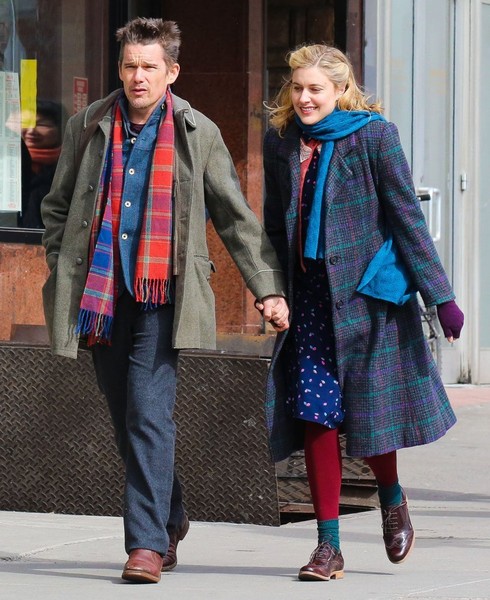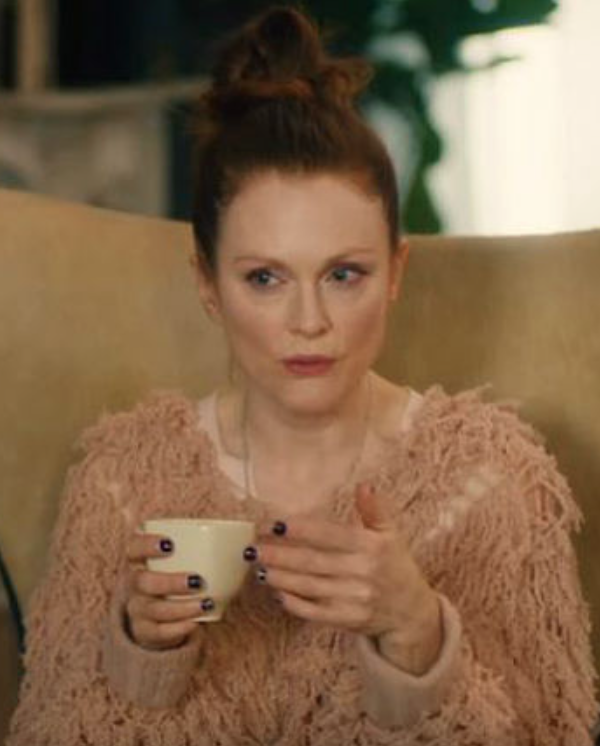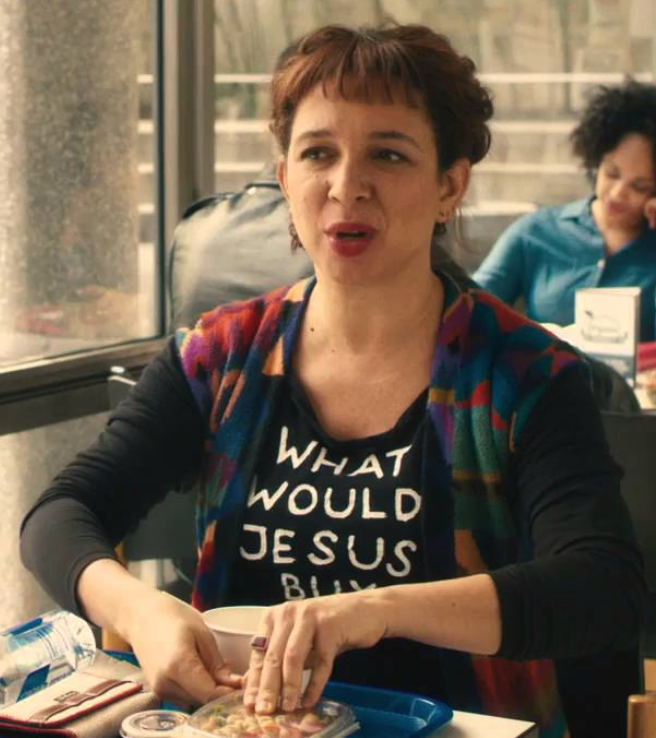 “Maggie’s Plan” is that rarest of ensemble films about attractive, overly educated New Yorkers (and that is a cinema genre unto itself): It doesn’t seem like a poor man’s Woody Allen. This may be because writer, director, novelist and painter Rebecca Miller knows something about emerging from a long shadow– her father is Arthur Miller and her husband is Daniel Day Lewis. I prefer to think, though, that it’s because she has a genuine fondness for humans in all their folly, which is a far cry from the latent misanthropy lurking in the works of such ostensible crowd-pleasers as Noah Baumbach, Nora Ephron, Nicole Holofcener, and, yes, Mr. Allen.
“Maggie’s Plan” is that rarest of ensemble films about attractive, overly educated New Yorkers (and that is a cinema genre unto itself): It doesn’t seem like a poor man’s Woody Allen. This may be because writer, director, novelist and painter Rebecca Miller knows something about emerging from a long shadow– her father is Arthur Miller and her husband is Daniel Day Lewis. I prefer to think, though, that it’s because she has a genuine fondness for humans in all their folly, which is a far cry from the latent misanthropy lurking in the works of such ostensible crowd-pleasers as Noah Baumbach, Nora Ephron, Nicole Holofcener, and, yes, Mr. Allen.
This is Miller’s first wholly New York City-based film, and it seems no coincidence that it is also her most delightful. Adapted from an as-yet unpublished novel by HarperCollins editor Karen Rinaldi, its milleau is a literary and academic world painted with the bold pastels and flourishes you might find in a Wes Anderson diorama. The titular Maggie (Greta Gerwig) is a university administrator who provides career guidance to art and design students. Clad head-to-toe in wool plaids and polka dots and perched in a tiny West Village apartment stuffed with handsome hardcover books, she’s like a Mary Poppins for the post-modernist set – one who takes constitutionals around Washington Square Park and chomps her salads with an uncanny dedication. A resolute pragmatist, thirtysomething Maggie announces at the film’s onset that, having assessed she’s incapable of remaining in love for more than six months, she’s pursuing single motherhood with a sperm donation from a socially awkward college pal who’s now an artisanal pickle entrepreneur. That she’s delivering this proclamation in a greenmarket to college boyfriend Tony (Bill Hader) and Max (Monte Green), his bespectacled toddler with Maggie’s good friend Felicia (Maya Rudolph), says it all: This film is expository and cozy all at once.
 Of course, the best-laid plans of mice, men, and Maggie oft go astray, so a long-burning crush makes a proclamation of his own just as our heroine is mid-insemination. That’s John (Ethan Hawke), the New School’s “bad boy of Ficto-Critical Anthropology” and wannabe novelist whose pages Maggie has been reading while stealing admiring glances at his grizzled profile. (It’s a patent unfairness that Hawke’s gravelly voice and laser intensity boasts more allure than they ever did in his gorgeously rumpled youth.) Outstripped by his brilliant, high-strung Danish colleague and wife, Georgette (Julianne Moore, with an inexplicably Teutonic accent and a perilously high bun), John is seeking to be the “precious flower” in a relationship. Maggie promptly tosses her impeccable ethics to the hills and picks up a hoe and spade.
Of course, the best-laid plans of mice, men, and Maggie oft go astray, so a long-burning crush makes a proclamation of his own just as our heroine is mid-insemination. That’s John (Ethan Hawke), the New School’s “bad boy of Ficto-Critical Anthropology” and wannabe novelist whose pages Maggie has been reading while stealing admiring glances at his grizzled profile. (It’s a patent unfairness that Hawke’s gravelly voice and laser intensity boasts more allure than they ever did in his gorgeously rumpled youth.) Outstripped by his brilliant, high-strung Danish colleague and wife, Georgette (Julianne Moore, with an inexplicably Teutonic accent and a perilously high bun), John is seeking to be the “precious flower” in a relationship. Maggie promptly tosses her impeccable ethics to the hills and picks up a hoe and spade.
Fast-forward three years, when we find more than she bargained for in her garden: husband John; their golden-haired tot, Lily; and John’s two Danish-speaking children from his marriage to Georgette, with whom he jaws every day in between desultory stabs at a still-uncompleted book project. (You sense some self-reproachment on the part of Rinaldi there.) Earnest Maggie wouldn’t even mind soldiering the sole financial and childcare burden of their three-parent triptych if her husband paid her a whit of attention. But since his self-absorption knows no bounds, she devises to reunite him with his ex, whose narcissism may have been necessary to erase his own, so that she can pursue her original plan of single motherhood.
Though heavily plotted, “Maggie’s Plan” remains light, possibly because it’s such a labor of love – a collaboration of love, really. Aided by director of photography Sam Levy, editor Sabine Hoffman, and music supervisor Adam Horovitz (aka Beastie Boy Ad-Rock), Miller whisks us away in a froth of color and texture and sound that never eclipses her stylishly staccato dialogue. In the press notes, Miller says she worked closely with the cast to develop their respective characters, and the results are intriguingly knowing:  Gerwig’s hyper-mannerly lumbering is, for once, rightly acknowledged as the elephant on the screen, and Moore is the most evilly funny she’s been since “The Big Lebowski”; There’s an irresistible glint in her eye when she purrs such lines as “No one unpacks commodity fetishism like you do.” Pairing “Saturday Night Live” veterans Rudolph and Hader is a clever short-cut as well. With their rubbery-faced double takes and raised eyebrows, they’re the quickest of Brooklyn-based Cassandras, complete with a dash of Harpo Marx.
Gerwig’s hyper-mannerly lumbering is, for once, rightly acknowledged as the elephant on the screen, and Moore is the most evilly funny she’s been since “The Big Lebowski”; There’s an irresistible glint in her eye when she purrs such lines as “No one unpacks commodity fetishism like you do.” Pairing “Saturday Night Live” veterans Rudolph and Hader is a clever short-cut as well. With their rubbery-faced double takes and raised eyebrows, they’re the quickest of Brooklyn-based Cassandras, complete with a dash of Harpo Marx.
But as broad as these people are, they’re less caricatures than cartoon characters adorably flopping about in a primary-colored sea of semiotics and organic almond milk. For this credit seems solely due Miller, who’s like a meta-modern Jane Austen, forever nosing at the line between deal breakers and acceptable flaws in human nature. What’s next? “Selfishness and Self-Possession”? Whatever the title, I’d pay many a tuppence to revisit these oversized wisecrackers.
This was originally published on Signature.
